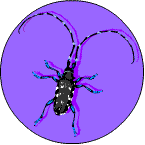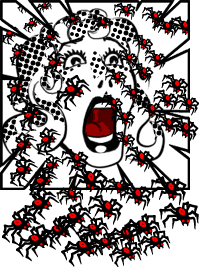A Mercifully Brief Introduction to Disgusting Insects and Insect Disorders
Created | Updated Apr 2, 2010
They first evolved a hundred gazillion years ago - and insects today make up around 75% of all knee-jerk, fright-response species. They may appear to be small and insignificant; but, upclose they represent about 99% of the disgusting factor on the planet.

An insect's body is generally composed of three parts; possibly more, but who wants to examine them that closely. These parts are: the disgusting part, the more disgusting part, and the thoroughly disgusting part. On the head is often a pair of antennae, unless they've been plucked off by cruel 11-year-olds. The mouth parts vary quite a bit, depending on the species; but are always too complexly gross and nauseating to even consider. Fortunately, most of us don't get that close. The legs are attached to the thorax, as are the wings, if they've helped them to avoid the 11-year-olds.
The size of insects is limited by the way in which they breathe; but not limited enough for the most of us. Still, 18mm cockroaches have a much harder time hiding than their 2mm relatives. The hard part is wrestling the large ones out the door.
Classification
A brief review of insect species will help to make them easier to categorise. Insects make up the class Insectum-Revulsa under the phylum Disgustous-Major in the animal kingdom. There are two sub-classes of Insectum-Revulsa: Acreepygoto (wingless) and Ptercreepygota (winged). Acreepygoto is the older, more squishable category sub-class. Ptercreepygota is the pestiest sub-class and in fact comprises two divisions: Eastcreepygota (the wings allow them to fly into your ear) and Westcreepygota (where they buzz around your head causing you to bash into things).

Insect Disorders
Below is a brief description of some of the medical disorders that insects are known to transmit, directly or indirectly.
Malaria: Deadly
Scarlet Fever: Deadly
Smallpox: Deadly
Plague: Deadly
(fill in name of country)-Flu: Mostly Deadly
There are also many orders of insect; but, since you have to get close enough to identify them, a detailed analysis will likely do no good and describing them in detail creates its own level of nausea.
Insect Disrespect
Below is a brief list of some of the ways that insects are known to pester humans (besides carrying diseases such as plague).
Biting, stinging, blood-sucking, nesting in hair or orifices, chewing our clothing, eating homes or furniture, ruining crops, buzzing, chirping, splattering on windshields, flying into the mouths of bikers, frightening women and small children, and being just generally unpleasant company, interfering with picnics, garden parties, and outdoor family reunions.
